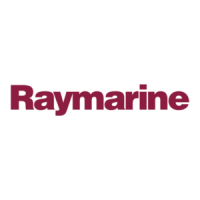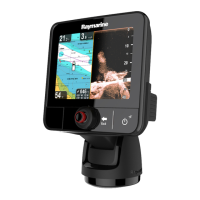
Do you have a question about the Raymarine E70163- a67 MFD Wi-Fi and is the answer not in the manual?
| Display Type | LCD |
|---|---|
| Wi-Fi | Yes |
| Chartplotter | Yes |
| Waterproof Rating | IPX6 and IPX7 |
| Touchscreen | Yes |
| Ethernet | Yes |
| Compass | Yes |
| Radar Capable | Yes |
| NMEA 2000 Compatible | Yes |
| Display Resolution | 640 x 480 pixels |
| Sonar | Yes |
| GPS | Built-in |
| Cartography | Navionics compatible |
Covers critical safety advice for installation, operation, and handling of the product and its components.
Explains normal color variations in TFT displays.
Details precautions for transducer cables, power supply, cards, chart door, sun covers, and cleaning.
Provides general information, audience, illustrations, and conventions used in the handbook.
Lists available display models, features, and details touch/non-touch operations.
Details compatible devices, connection protocols, system limits, and networking constraints.
Illustrates system setups, explains protocols, and the role of the data master.
Lists parts supplied with different models and the tools required for installation.
Covers cable types, routing, strain relief, circuit isolation, and cable shielding.
Details available connections across models and power connection procedures for New a Series and c/e Series.
Explains network, GPS, AIS, SeaTalkng, NMEA, and video connections.
Describes connecting media players, Bluetooth devices, and Wi-Fi for mobile apps.
Discusses general requirements, ventilation, mounting surface, cable entry, water ingress, electrical interference, power supply, and compass safe distance.
Covers viewing angle considerations, product dimensions, surface mounting, and front/rear bezel attachment for the New a Series.
Details viewing angle, product dimensions, and mounting procedures for New c/e Series displays.
Explains how to power the display on/off, use standby mode, and details controls for New a Series.
Describes controls for e7/e7D and c/e Series, Hybridtouch, touchscreen, and homescreen layouts.
Covers GPS checks, radar checks, sonar selection, and basic navigation through applications.
Details how to manage pages, rename, delete, reset homescreens, and adjust display preferences.
Explains editing information, numerical settings, basic touchscreen operations, and status symbols.
Explains the use of memory cards for data archiving, backup, insertion, and removal.
Details procedures for saving, retrieving, and erasing waypoints, routes, tracks, and settings.
Explains how to take screenshots and reset the system to factory defaults.
Introduces the PDF viewer, its features, and how to open and browse documents.
Explains how to navigate, zoom, select pages, and search for text within PDF documents.
Explains how to engage, disengage, and control the autopilot using shortcuts, pilot button, or chart application.
Details the symbols used to indicate autopilot status modes in the databar.
Describes how autopilot alarms are displayed, silenced, and handled.
Explains how to activate, cancel, and silence the MOB alarm and its operation.
Describes how alarms alert the user and how to configure their behavior.
Explains connecting a DSC VHF radio to display distress messages and GPS position data.
Details steps to enable DSC alerts and conditions for displaying distress messages.
Explains the fuel manager's purpose, operation, setup, and fuel logging.
Guides on setting up low fuel alarms and utilizing the fuel range ring feature for distance estimation.
Introduces AIS, its features, prerequisites, and how it works to complement radar.
Explains the context menu for target info and how to display AIS vectors and status symbols.
Covers silent mode, target symbols, detailed information, collision avoidance, and safety messages.
Details AIS options, alarms, and the buddy tracking feature for managing contacts.
Explains waypoints, how they are displayed in different applications, and how to manage them.
Details how to build, navigate, and manage routes, including route from track and reverse navigation.
Explains how to create, set intervals for, and manage tracks, including reviewing and editing them.
Lists the storage limits for waypoints, routes, and tracks on the display.
Introduces the chart app, its uses, datum, card compatibility, ranging, panning, and vessel position/orientation.
Covers 2D/3D chart views, manipulating the 3D view, and accessing the chart context menu.
Details My Data options, navigation options, measuring tools, and chart vectors.
Explains current and tide information, chart object details, and chart presentation settings.
Introduces radar, its features, and compatibility with different scanner types.
Details radar display overview, dual range operation, and radar mode/orientation settings.
Explains on-screen gain controls, HD/SuperHD adjustments, and non-HD adjustments.
Covers dual range, orientation, enhance echoes, waypoints, and data overlay options.
Details Guard Zone and MARPA functions for target tracking and collision avoidance.
Explains scanner set-up menu options and how to reset the radar.
Explains how the fishfinder works, sonar modules, and traditional vs. CHIRP sonar technology.
Covers fishfinder overview, context menu, status icons, display modes (Zoom, A-Scope), and scrolling.
Details how to interpret the sonar image, factors influencing the display, and target depth.
Explains available presets, changing preset names, resetting defaults, and frequency controls for non-CHIRP and CHIRP sonar.
Covers sensitivity settings like gain, color gain, TVG, and fishfinder presentation options.
Details measuring depth/distance, adjusting scrolling, setting waypoints, fishfinder alarms, and resetting the sonar.
Introduces the data application for viewing system and instrument data.
Lists default datapages and the data items displayed for different display variants.
Explains how to change datapage order, customize content, rename, add/delete datapages, and set engine/RPM details.
Introduces the thermal camera app for controlling and displaying thermal camera images.
Explains the thermal video feed, status icons, and available controls for pan, tilt, and zoom.
Details controls for rotary, joystick, and OK buttons, and explains Flat Field Correction (FFC).
Covers power up/standby, pausing images, setting home position, and surveillance modes.
Explains how to adjust contrast, scene presets, color modes, and reverse video polarity.
Details menu options for pan/tilt cameras with new/old interfaces, including image options and setup.
Provides power usage for different camera states and modes, and details user programmable buttons.
Introduces the application for controlling and displaying fixed mount thermal cameras.
Explains the thermal video feed and status icons for fixed mount cameras.
Details the controls available for fixed mount thermal cameras.
Covers power up/standby and pausing images for fixed mount cameras.
Explains how to adjust contrast, scene presets, and color modes for fixed mount cameras.
Lists the menu options available for configuring fixed mount thermal cameras.
Introduces the camera application for viewing camera or video feeds and cycling through available feeds.
Explains how the multifunction display can control a connected Fusion entertainment system.
Details the layout and controls for various media sources like iPod, USB, DVD, and Radio.
Guides on how to browse music available on connected iPod or USB devices.
Explains how to set repeat folder or shuffle play order functions.
Details how to adjust volume levels per zone and tone controls (Bass, Middle, Treble).
Explains how to select the zone or Fusion system the application will control.
Lists available menu options for browsing music, repeat, shuffle, tone controls, select system, preset, and scan.
Introduces the weather app, its usage, setup steps, and accessing the application.
Details the display overview, weather symbols, storm tracking, and map navigation.
Covers viewing weather information, reports, animated graphics, and menu options.
Provides definitions for various weather-related terms.
Explains controlling a Raymarine Sirius receiver, accessing the app, changing channels, favorites, and volume.
Introduces Raymarine apps (RayView, RayControl, RayRemote), functionality, and device compatibility.
Details enabling Wi-Fi, mobile apps, Wi-Fi security setup, and channel selection.
Covers language selection, customizing boat details (type, engines, fuel), and specifying preferred units of measurement.
Details time/date setup, key beep, cursor autohide, range controls, shared brightness, and screenshot file settings.
Explains databar/cell customization, lists data items, and covers system set-up menus like alarms and maintenance.
States the product has no user-serviceable components and advises referring to authorized dealers for repair.
Provides best practices for cleaning the product, including display case and screen, to avoid damage.
Provides general troubleshooting guidance and addresses power-up problems.
Covers common problems and solutions for radar, GPS, and sonar systems.
Addresses issues with thermal cameras, system data connectivity, video, and Wi-Fi/Bluetooth.
Covers touchscreen troubleshooting and other miscellaneous problems like erratic behavior or resets.
Provides contact information for Raymarine customer support via website, phone, and email.
Lists contact details for third-party suppliers like Navionics and Sirius.
Covers physical dimensions, weight, power supply, fuse/breakers, power consumption, and display specs for various series.
Details environmental specs, data connections (NMEA, Network, Wi-Fi, Bluetooth), internal GPS, and sonar specs.
Lists video, electronic chart, and conformance certifications.
Lists various network cables (RayNet, SeaTalkhs) and video cables required for connections.
Lists spare parts available for a65/a67, e7/e7D, e95/e97/c95/c97, e125/e127/c125/c127, and e165 models.
Details the pinouts and cable cores/colors for power, data, and video connections.
Provides pinout details for network (RJ45) and SeaTalkng connectors.
Details the pinout for video input/output connectors.
Explains how the display integrates with vessel control systems for monitoring and control.
Details switch panel configuration and how to load a configuration file.
Describes the switch panel overview, page examples, and how to use switches on touchscreen and with joystick.
Details significant features added in V6.xx, including audio, Fusion, switch panel, and thermal camera support.
Highlights features from V5.27, such as Fuel Manager, PDF Viewer, and improved thermal camera support.
Covers improvements in V4.32 (on-screen controls) and earlier versions like V3.15 (CHIRP, AIS) and V2.10 (cartography, diagnostics).











